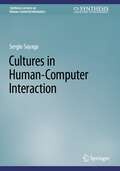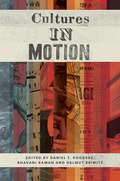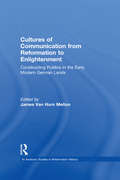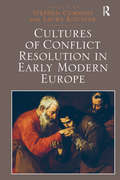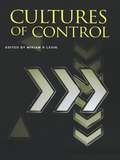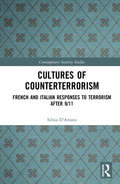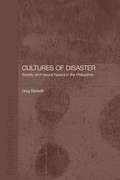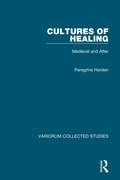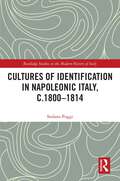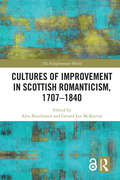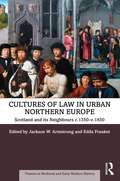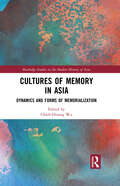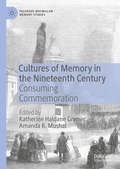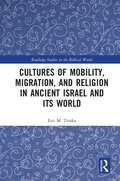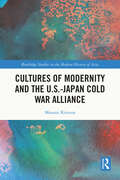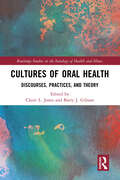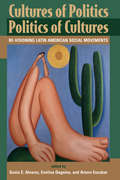- Table View
- List View
Cultures in Human-Computer Interaction (Synthesis Lectures on Human-Centered Informatics)
by Sergio SayagoThis book provides an interdisciplinary synthesis of the topic of culture in the context of Human-Computer Interaction (HCI) and a structured overview of a large body of HCI research on (and with) culture. The book presents a short and guided overview of the concept of culture. It offers some background on the origin and development of the term culture. It also outlines some of its key traits and ingredients and summarizes three main perspectives of culture across disciplines. The book argues that culture matters considerably in HCI and discusses a number of reasons for and against its relevance. Arguments against include a lack of a universal or common definition of the term culture and globalization. Arguments in favor touch upon important aspects of HCI, including a diversely growing user base, the need to provide designers with enough support to design across cultures, and the inseparable relationship between culture and technology. The issues explored in this book can be classified into three, non-mutually exclusive, categories: theoretical, practical, and controversial. The book outlines the main conceptual perspectives of culture within HCI, including Geert Hofstede’s cultural dimensions theory, Edward T. Hall’s cross-cultural theory of communication, and Richard Nisbett’s cultural cognitive systems of thought as well as examining the ways in which culture has been operationalized in HCI research and the main functions of culture in this area. It closes with a discussion of some open issues intended to spark debate and future research. The literature this book draws upon covers a wide range of research disciplines, including Anthropology, Sociology, Cultural Studies, Robotics, Disability Studies, Cultural and Cross-Cultural Psychology, Usability, and Design. This book aspires to provide a useful overview of culture for HCI scholars at all levels.
Cultures in Motion
by Daniel T. Rodgers Helmut Reimitz Bhavani RamanIn the wide-ranging and innovative essays of Cultures in Motion, a dozen distinguished historians offer new conceptual vocabularies for understanding how cultures have trespassed across geography and social space. From the transformations of the meanings and practices of charity during late antiquity and the transit of medical knowledge between early modern China and Europe, to the fusion of Irish and African dance forms in early nineteenth-century New York, these essays follow a wide array of cultural practices through the lens of motion, translation, itinerancy, and exchange, extending the insights of transnational and translocal history. Cultures in Motion challenges the premise of fixed, stable cultural systems by showing that cultural practices have always been moving, crossing borders and locations with often surprising effect. The essays offer striking examples from early to modern times of intrusion, translation, resistance, and adaptation. These are histories where nothing--dance rhythms, alchemical formulas, musical practices, feminist aspirations, sewing machines, streamlined metals, or labor networks--remains stationary. In addition to the editors, the contributors are Celia Applegate, Peter Brown, Harold Cook, April Masten, Mae Ngai, Jocelyn Olcott, Mimi Sheller, Pamela Smith, and Nira Wickramasinghe.
Cultures of Care in Irish Medical History, 1750–1970
by Catherine Cox Maria LuddyExploring aspects of Irish medical history, from the nature and proposed remedies for various illnesses in eighteenth century Ireland, to the treatment of influenza in twentieth-century Ireland, this book shows how the cultures of medical care evolved over three centuries.
Cultures of Collecting (Critical Views)
by J. ElsnerThis book traces the psychology, history and theory of the compulsion to collect, focusing not just on the normative collections of the Western canon, but also on collections that reflect a fascination with the "Other" and the marginal – the ephemeral, exotic, or just plain curious. There are essays on the Neoclassical architect Sir John Soane, Sigmund Freud and Kurt Schwitters, one of the masters of collage. Others examine imperialist encounters with remote cultures – the consquitadors in America in the sixteenth century, and the British in the Pacific in the eighteenth – and the more recent collectors of popular culture, be they of Swatch watches, Elvis Presley memorabilia or of packaging and advertising. With essays by Jean Baudrillard, Thomas DaCosta Kaufmann, Nicholas Thomas, Mieke Bal, John Forrester, John Windsor, Naomi Schor, Susan Stewart, Anthony Alan Shelton, John Elsner, Roger Cardinal and an interview with Robert Opie.
Cultures of Communication from Reformation to Enlightenment: Constructing Publics in the Early Modern German Lands (St Andrews Studies in Reformation History)
by James Van Horn MeltonFocusing on the territories of the Holy Roman Empire from the early Reformation to the mid-eighteenth century, this volume of fifteen interdisciplinary essays examines some of the structures, practices and media of communication that helped shape the social, cultural, and political history of the period. Not surprisingly, print was an important focal point, but it was only one medium through which individuals and institutions constructed publics and communicated with an audience. Religious iconography and ritual, sermons, music, civic architecture, court ceremony, street gossip, acts of violence, are also forms of communication explored in the volume. Bringing together scholars from diverse disciplines and scholarly backgrounds, this volume transcends narrow specializations and will be of interest to a broad range of academics seeking to understand the social, political and cultural consequences of the "information revolution" of Reformation Europe.
Cultures of Communication: Theologies of Media in Early Modern Europe and Beyond
by Helmut Puff Christopher Wild Ulrike StrasserContrary to the historiographical commonplace “no Reformation without print” Cultures of Communication examines media in the early modern world through the lens of the period’s religious history. Looking beyond the emergence of print, this collection of ground-breaking essays highlights the pivotal role of theology in the formation of the early modern cultures of communication. The authors assembled here urge us to understand the Reformation as a response to the perceived crisis of religious communication in late medieval Europe. In addition, they explore the novel demands placed on European media ecology by the acceleration and intensification of global interconnectedness in the early modern period. As the Christian evangelizing impulse began to propel growing numbers of Europeans outward to the Americas and Asia, theories and practices of religious communication had to be reformed to accommodate an array of new communicative constellations – across distances, languages, cultures.
Cultures of Computation and Quantification in the Ancient World: Numbers, Measurements, and Operations in Documents from Mesopotamia, China and South Asia (Why the Sciences of the Ancient World Matter #6)
by Karine Chemla Agathe Keller Christine ProustThis book sheds light on the variety of mathematical cultures in general. To do so, it concentrates on cultures of computation and quantification in the ancient world, mainly in ancient China, South Asia, and the Ancient Near East and offers case studies focused on numbers, quantities, and operations, in particular in relation to mathematics as well as administrative and economic activities. The various chapters focus on the different ways and contexts of shaping numbers and quantities, and on the procedures applied to them. The book places special emphasis on the processes of emergence of place-value number systems, evidenced in the three geographical areas under study All these features yield essential elements that will enable historians of mathematics to further capture the diversity of computation practices in their contexts, whereas previous historical approaches have tended to emphasize elements that displayed uniformity within “civilizational” blocks. The book includes editions and translations of texts, some of them published here for the first time, maps, and conventions for editions of ancient texts. It thereby offers primary sources and methodological tools for teaching and learning. The volume is aimed at historians and philosophers of science and mathematics, historians of the ancient worlds, historians of economics, sinologists, indologists, assyriologists, as well as undergraduate, graduate students and teachers in mathematics, the history and philosophy of science and mathematics, and in the history of ancient worlds.
Cultures of Conflict Resolution in Early Modern Europe
by Laura Kounine Edited Stephen CumminsDisputes, discord and reconciliation were fundamental parts of the fabric of communal living in early modern Europe. This edited volume presents essays on the cultural codes of conflict and its resolution in this period under three broad themes: peacemaking as practice; the nature of mediation and arbitration; and the role of criminal law in conflicts. Through an exploration of conflict and peacemaking, this volume provides innovative accounts of state formation, community and religion in the early modern period.
Cultures of Contagion
by Thomas PikettyContagion as process, metaphor, and timely interpretive tool, from antiquity to the twenty-first century.Cultures of Contagion recounts episodes in the history of contagions, from ancient times to the twenty-first century. It considers contagion not only in the medical sense but also as a process, a metaphor, and an interpretive model--as a term that describes not only the transmission of a virus but also the propagation of a phenomenon. The authors describe a wide range of social, cultural, political, and anthropological instances through the prism of contagion--from anti-Semitism to migration, from the nuclear contamination of the planet to the violence of Mao's Red Guard. The book proceeds glossary style, with a series of short texts arranged alphabetically, beginning with an entry on aluminum and "environmental contagion" and ending with a discussion of writing and "textual resemblance" caused by influence, imitation, borrowing, and plagiarism. The authors--leading scholars associated with the Center for Historical Research (CRH, Centre de recherches historiques), Paris--consider such topics as the connection between contagion and suggestion, "waltzmania" in post-Terror Paris, the effect of reading on sensitive imaginations, and the contagiousness of yawning. They take two distinct approaches: either examining contagion and what it signified contemporaneously, or deploying contagion as an interpretive tool. Both perspectives illuminate unexpected connections, unnoticed configurations, and invisible interactions.
Cultures of Control (Routledge Studies in the History of Science, Technology and Medicine #Vol. 9)
by Miriam R. LevinThis collection of essays explores the history of control by looking at a variety of cultural forms, practices, and beliefs. These ideas are examined critically, not only in the light of the possibilities which control technologies seem to offer for resolving human problems, but also the contradictory moral, political, and economic consequences they have had. The discussion takes into account the important modes in which humans have cast their organizational efforts: political, social, sychological, economic, and legal. It also takes a longue durée view of the history of control, looking back to the eighteenth and nineteenth centuries, and establishes the continuities in the twentieth century as a transatlantic phenomenon.
Cultures of Correspondence in Early Modern Britain (Material Texts)
by Andrew Gordon James DaybellThe letter is a powerfully evocative form that has gained in resonance as the habits of personal letter writing have declined in a digital age. But faith in the letter as evidence of the intimate thoughts of individuals underplays the sophisticated ways letters functioned in the past. In Cultures of Correspondence in Early Modern Britain leading scholars approach the letter from a variety of disciplinary perspectives to uncover the habits, forms, and secrets of letter writing. Where material features of the letter have often been ignored by past generations fixated on the text alone, contributors to this volume examine how such elements as handwriting, seals, ink, and the arrangement of words on the manuscript page were significant carriers of meaning alongside epistolary rhetorics. The chapters here also explore the travels of the letter, uncovering the many means through which correspondence reached a reader and the ways in which the delivery of letters preoccupied contemporaries. At the same time, they reveal how other practices, such as the use of cipher and the designs of forgery, threatened to subvert the surveillance and reading of letters.The anxiety of early modern letter writers over the vulnerability of correspondence is testament to the deep dependence of the culture on the letter. Beyond the letter as a material object, Cultures of Correspondence sheds light on textual habits. Individual chapters study the language of letter writers to reveal that what appears to be a personal and unvarnished expression of the writer's thought is in fact a deliberate, skillful exercise in managing the conventions and expectations of the form. If letters were a prominent and ingrained part of the cultural life of the early modern period, they also enjoyed textual and archival afterlives whose stories are rarely told. Too often studied only in the case of figures already celebrated for their historical or literary significance, the letter in Cultures of Correspondence emerges as the most vital and wide-ranging material, textual form of the early modern period.Contributors: Nadine Akkerman, Mark Brayshay, Christopher Burlinson, James Daybell, Jonathan Gibson, Andrew Gordon, Arnold Hunt, Lynne Magnusson, Michelle O'Callaghan, Alan Stewart, Andrew Zurcher.
Cultures of Counterproliferation: The Making of US and Israeli Policy on Iran's Nuclear Program (Routledge Global Security Studies)
by Raphael BenLeviThis book argues that the nature of counterproliferation strengthens the effect of cultural factors in policy choices, and illustrates this by focusing on US and Israeli policy toward the Iranian nuclear program. The United States and Israel have been the two states most active in opposing Iran’s nuclear ambitions; however, the respective strategies of each of these states have changed repeatedly. This book explores how competing cultural schools of thought on grand strategy within each state inform and shape the key policy decisions in their attempts to prevent a nuclear Iran. Drawing on numerous interviews conducted with former high-level officials in each country as well as published memoirs, this book first describes in detail the belief systems of the competing schools and then analyses the internal debates and key decisions on policy toward the Iranian Nuclear Program, while critically assessing the extent to which these beliefs influenced policy in the face of material-structural pressures. This in-depth analysis of the internal debates and dilemmas within the national leadership of the two states most prominent in the effort to prevent a nuclear Iran constitutes an indispensable guide for scholars and policymakers who will inevitably face similar dilemmas in dealing with this ongoing challenge and additional cases of nuclear proliferation around the world. This book will be of much interest to students of nuclear proliferation, US and Israeli foreign policy, Middle Eastern politics and IR in general.
Cultures of Counterterrorism: French and Italian Responses to Terrorism after 9/11 (Contemporary Security Studies)
by Silvia D'AmatoThis book investigates counterterrorism responses from a strategic-culturalist perspective, focusing on France and Italy in the post-9/11 era. Terrorism occupies a predominant space within contemporary political debate across all European countries. Recent attacks in Europe have raised many questions about the status of counterterrorism structures within European countries, revealing a wide range of practical as well as discursive security implications. This work provides an original contribution to the understanding of counterterrorism by asking how values, norms, and a shared sense of identity matter in policy dynamics. It explores and assesses which cultural elements are relevant for the fight against terrorism and investigates the impact which these elements can have on practical approaches to terrorism. Despite the current attention to terrorist attacks in Europe, the cases of France and Italy in counterterrorism affairs are particularly overlooked by the existing literature; this book analyses, questions, and examines the strategy of these two countries through the instruments offered by the culturalist approaches to strategy. This book will be of much interest to students of terrorism studies, discourse analysis, European politics, security studies, and international relations in general.
Cultures of Disaster: Society and Natural Hazard in the Philippines
by Greg BankoffIn this fascinating and comprehensive study, Greg Bankoff traces the history of natural hazards in the Philippines from the records kept by the Spanish colonisers to the 'Calamitous Nineties', and assesses the effectiveness of the relief mechanisms that have evolved to cope with these occurrences. He also examines the correlation between this history of natural disasters and the social hierarchy within Filipino society. The constant threat of disaster has been integrated into the schema of daily life to such an extent that a 'culture of disaster' has been formed.
Cultures of Healing: Medieval and After (Variorum Collected Studies)
by Peregrine HordenThis volume brings together for the first time an updated collection of articles exploring poverty, poor relief, illness, and health care as they intersected in Western Europe, the Mediterranean and the Middle East, during a ‘long’ Middle Ages. It offers a thorough and wide-ranging investigation into the institution of the hospital and the development of medicine and charity, with focuses on the history of music therapy and the history of ideas and perceptions fundamental to psychoanalysis. The collection is both sequel and complement to Horden’s earlier volume of collected studies, Hospitals and Healing from Antiquity to the Later Middle Ages (2008). It will be welcomed by all those interested in the premodern history of healing and welfare for its breadth of scope and scholarly depth.
Cultures of Identification in Napoleonic Italy, c.1800–1814 (Routledge Studies in the Modern History of Italy)
by Stefano PoggiThrough the lens of identification procedures, this book examines how the processes of state-building affected European societies during the Napoleonic period. By focusing on the Kingdom of Italy, the author shows how the top-down change usually associated with Napoleonic state-building had to compete and share spaces with the agencies of other often-neglected actors such as local bureaucrats, the clergy, and common people.What emerges is the coexistence of different understandings of personal identities, defined as “cultures of identification”. One was rooted in the traditional habits of the population and based on a continuous performance of identities, allowing for a certain degree of fluidity. The other, promoted by the Napoleonic administration, envisaged legal and fixed identities that were to be managed directly by agents of the state. Personal identification in Napoleonic Italy was thus more of a battleground than a mere field of action for the “modernizing” activities of state authorities.Analyzing a period of momentous change for European societies, Cultures of Identification can be profitably read by students and researchers interested in the history of state-building, policing, social control, and personal identification.
Cultures of Improvement in Scottish Romanticism, 1707-1840 (The Enlightenment World: Political and Intellectual History of the Long Eighteenth Century)
by Alex Benchimol Gerard Lee McKeeverThe first applied research volume in Scottish Romanticism, this collection foregrounds the concept of progress as 'improvement' as a constitutive theme of Scottish writing during the long eighteenth century. It explores improvement as the animating principle behind Scotland’s post-1707 project of modernization, a narrative both shaped and reflected in the literary sphere. It represents a vital moment in Romantic studies, as a 'four-nations' interrogation of the British context reaches maturity. Equally, the volume contributes to a central concern in the study of Scottish culture, amplifying a critical synthesis of Romanticism and Enlightenment. The conceptual motif of improvement allows an illumination of the boundaries (and beyond) of conventional notions of Romanticism, tracing its long, evolving imbrication with Enlightenment in Scotland. Exploring the holistic treatment of improvement in Scottish literature, chapter-studies include work on agricultural improvement and processes of commercialization, polite cultural renewal and the cotton trade, an expanding print culture and spirituality in death rituals. Taken as a whole, this amounts to an interdisciplinary re-consideration of the central role of improvement in Scottish cultural history of the long eighteenth century, of interest to a wide range of scholars, reflecting the vitality of the exchange between Enlightenment and Romanticism in Scotland.
Cultures of Law in Urban Northern Europe: Scotland and its Neighbours c.1350–c.1650 (Themes in Medieval and Early Modern History)
by Jackson W. Armstrong and Edda FrankotDrawing together an international team of historians, lawyers and historical sociolinguists, this volume investigates urban cultures of law in Scotland, with a special focus on Aberdeen and its rich civic archive, the Low Countries, Norway, Germany and Poland from c. 1350 to c. 1650. In these essays, the contributors seek to understand how law works in its cultural and social contexts by focusing specifically on the urban experience and, to a great extent, on urban records. The contributions are concerned with understanding late medieval and early modern legal experts as well as the users of courts and legal services, the languages and records of law, and legal activities occurring inside and outside of official legal fora. This volume considers what the expectations of people at different status levels were for the use of the law, what perceptions of justice and authority existed among different groups, and what their knowledge was of law and legal procedure. By examining how different aspects of legal culture came to be recorded in writing, the contributors reveal how that writing itself then became part of a culture of law. Cultures of Law in Urban Northern Europe: Scotland and its Neighbours c.1350–c.1650 combines the historical study of law, towns, language and politics in a way that will be accessible and compelling for advanced level undergraduates and postgraduate to postdoctoral researchers and academics in medieval and early modern, urban, legal, political and linguistic history.
Cultures of Learning: Mapping the New Spaces of Critical Pedagogy in India
by Suresh Babu G.S Arunima NaithaniThis book looks at educational institutions and their role as sites of learning in times of moral and political chaos. It highlights the erosion of critical pedagogical traditions in universities in India and registers the ongoing responses and struggles as educational experiences.This book develops a critical approach by redefining education from the perspective of learning as a political act to experience the complex network of learning activities beyond the confines of educational institutions. It also locates caste, gender and religious hierarchies in schools and universities in India. The book explores the extremely contradictory experiences of academic spaces that have resulted in the development of uncharted sites of learning. Being mindful of these multiple strands, the authors examine the culture of learning and reflect on the space for critical learning, activism, dissent and self-reflexivity in schools and universities in India. The goal of diverse experiences of learning is to derive new meaning to the conceptions of critical pedagogy as a political act for democratising education.This transdisciplinary book will be of interest to students and researchers of education, sociology, history, political studies and public policy.
Cultures of Memory in Asia: Dynamics and Forms of Memorialization (Routledge Studies in the Modern History of Asia)
by Chieh-Hsiang WuA collection of works by Asian scholars looking at different ways in which relatively recent traumas have been memorialized in their various countries, often while the traumas themselves are ongoing, or the memories of them contested. Memory studies typically focuses on the study of memorialization after traumatic incidents are overcome, in Asia, however, the past and the present remain closely intertwined. Between the legacies of the Japanese Empire, the respective suppressions by the Kuomintang and the People’s Republic of China, and the ongoing protests in much of Southeast Asia against oppressive governments and laws, memorialization is occurring while the histories are still being contested. The contributors to this book are Asian scholars examining the memorializing of events in the countries of Asia, including China, Taiwan, Japan, Korea, Thailand and the Philippines, using local language sources. They look at a broad range of media of memorialization, encompassing statues, cemeteries, testimonial literature, and film among others. An insightful resource for scholars of memory and cultural studies, as well as those of twentieth and twenty-first century Asian history.
Cultures of Memory in the Nineteenth Century: Consuming Commemoration (Palgrave Macmillan Memory Studies)
by Amanda R. Mushal Katherine Haldane GrenierThis collection provides a long-overdue examination of the nineteenth century as a crucible of new commemorative practices. Distinctive memory cultures emerged during this period which would fundamentally reshape public and private practices of remembrance in the modern world. The essays in this volume bring together scholars of History, Literature, Art History, and Musicology to explore uses of memory in nineteenth-century empire-building and constructions of national identity, cultures of sentiment and mourning practices, and discourses of race and power. Contributors approach the topic through case studies of Europe, the United States, and the British Empire. Their analyses of nineteenth-century innovations in commemoration at both the personal and the larger civic and political levels will appeal to students and scholars of memory and of the nineteenth-century world.
Cultures of Mobility, Migration, and Religion in Ancient Israel and Its World (Routledge Studies in the Biblical World)
by Eric M. TrinkaThis book examines the relationship between mobility, lived religiosities, and conceptions of divine personhood as they are preserved in textual corpora and material culture from Israel, Judah, Egypt, and Mesopotamia. By integrating evidence of the form and function of religiosities in contexts of mobility and migration, this volume reconstructs mobility-informed aspects of civic and household religiosities in Israel and its world. Readers will find a robust theoretical framework for studying cultures of mobility and religiosities in the ancient past, as well as a fresh understanding of the scope and texture of mobility-informed religious identities that composed broader Yahwistic religious heritage. Cultures of Mobility, Migration, and Religion in Ancient Israel and Its World will be of use to both specialists and informed readers interested in the history of mobilities and migrations in the ancient Near East, as well as those interested in the development of Yahwism in its biblical and extra-biblical forms.
Cultures of Modernity and the U.S.-Japan Cold War Alliance (Routledge Studies in the Modern History of Asia)
by Masami KimuraCultures of Modernity and the U.S.-Japan Cold War Alliance reconsiders the origins of postwar U.S.-Japan relations by focusing on “modernization” ideologies that the Americans and the Japanese shared in the 1940s–early 1950s. Mobilizing a wealth of English and Japanese-language sources, the author identifies parallel groups of modernist thinkers in America and Japan – including politicians, bureaucrats, intellectuals, scholars, and journalists – and follows how different strands of thought played out within an evolving political environment, forming a “middle ground.” Despite their differences, both the Americans and the Japanese believed in the progressive view of history, considered Japan to be still underdeveloped, and therefore agreed on the advisability of democratizing Japan – which included constitutional reform. Whether proponents or opponents of the U.S.-Japan Cold War alliance system, they also shared the vision of Wilsonian internationalism and devised similar designs for a postwar Asian order where Japan would rejoin. Thus, by showing how the confluence of modernist cultures helped forge a postwar relationship between the two, this study contributes to the field of postwar U.S.-Japan relations by supplementing and reorienting the scope of scholarship, one that has been predominantly America-centered and framed along the line of diplomatic narratives informed by Cold War politics.
Cultures of Oral Health: Discourses, Practices and Theory
by Claire L. JonesOral health is integral to well-being and quality of life. This important edited volume brings together leading scholars to address global oral health and the multiple ways in which theory, practice and discourse have shaped it in the modern period. Structured around key themes, the book chapters draw on interdisciplinary perspectives in order to consider the role of the dental profession, the commercial sector, charities, the state, the media and patients in shaping oral health in the past and present. Collectively, the chapters consider the extent to which each of the studied groups and actors have sought to own and control the mouth. By adopting multiple perspectives, the book highlights the importance of cross-disciplinary work across the sciences, social sciences and humanities and provides a road map for a new interdisciplinary field focused on oral health and society. Drawing on perspectives from dentistry, sociology, history and the wider humanities, this book will interest students and researchers of dentistry, public health, sociology of health and illness, the medical humanities and history.
Cultures of Politics, Politics of Cultures: Revisioning Latin American Social Movements
by Sonia E Alvarez<p>Investigating the complex interrelations between culture and politics in a wide range of social movements in Latin America, this book focuses on the cultural politics enacted by social movements as they struggle for new visions and practices of citizenship, democracy, social relations, and development. The volume explores the potential of these cultural politics for fostering alternative political cultures and social transformations. Theoretical and empirical chapters assess and build upon novel conceptions of culture and politics in a variety of disciplines and fields—particularly anthropology, political science, sociology, feminist theory, and cultural studies. <p>The notion of the cultural politics of social movements provides a lens for analyzing emergent discourses and practices grounded in society and culture, the state and political institutions, and the extent to which they may unsettle, or be reinscribed into, the dominant neoliberal strategies of the 1990s. Contributors explore how social movements—urban popular, women's, indigenous, and black movements as well as movements for citizenship and democracy—engage in the cultural resignification of notions such as rights, equality, and difference, thus altering what counts as political. By highlighting simultaneously the cultural dimensions of the political and the political dimensions of the cultural, the book transcends the distinction between “new” and “old” social movements and thus significantly renews our understanding of them.</p>
